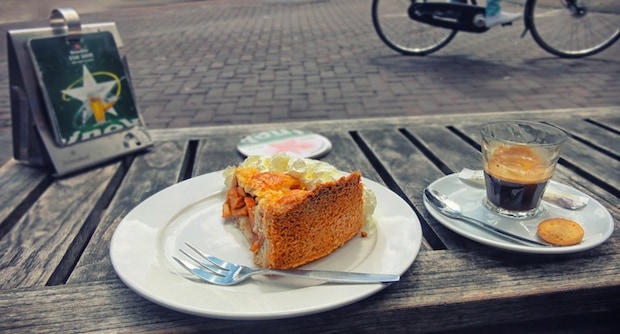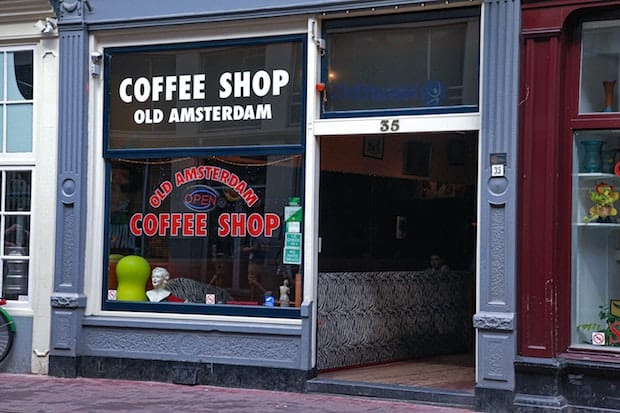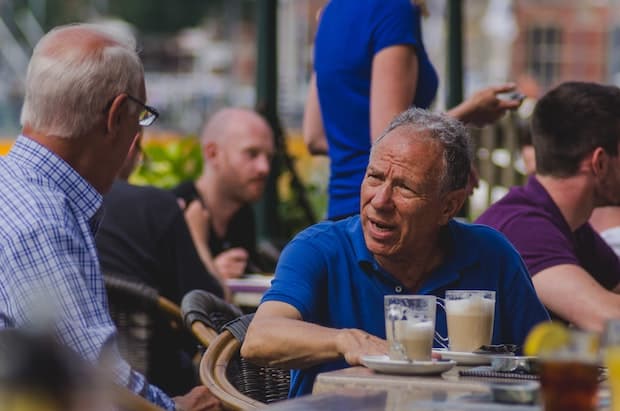Last Updated on December 6, 2023
Dutch coffee culture has a complicated history. The Dutch were pivotal in the emergence of the global coffee trade, but it was built on oppression and exploitation during the colonial period.
Holland has had affordable and abundant access to coffee for centuries, but has been slow to embrace the artisanal cafe culture now found in Scandinavian countries.
Most Dutch people still prefer regular coffee without much fuss, but they highly value a quick coffee break to warm up and connect with the community, and will take as many as they can throughout the day.

History of Netherlands coffee culture
The Dutch were instrumental in the spread of coffee throughout the world. When Yemen banned the export of coffee beans in the 1600s, the Dutch skirted the law by exporting coffee plants and developing coffee farms in their colonies, predominantly the islands of Indonesia, which remain one of the world’s top coffee producing regions to this day.
A certain percentage of production was set aside for the homeland and the Dutch were able to import coffee beans from their colonies tax-free, making coffee both abundant and affordable.
Coffee quickly became a social beverage, and has remained central to Dutch culture, but surprisingly the Netherlands, unlike its northern neighbors, has been slow to adopt the “third wave” of cafe culture. Artisanal cafes like Amsterdam’s Hummingbird are beginning to pop up around the country, but the Dutch have not been as eager to embrace this refined and more expensive style of artisan coffee.
View this post on Instagram
Current Netherlands coffee culture
The Dutch drink a lot of coffee. As with their Nordic neighbours, the cold climate is likely a driver of this obsessive consumption of the warm and elevating beverage. They take every opportunity for a coffee break, to huddle inside a cozy cafe and escape the elements. Enjoying coffee is social in nature, and you’ll always be offered a cup of coffee when you visit someone’s home. You’ll want to ensure you do the same if you have people over to your place as well.
It’s definitely quantity over quality in the Netherlands, with large pots of filter coffee still being the most common. Many people have embraced the convenience of capsule coffee machines.
Dutch companies Philips and Douwe Egberts came together for the creation of the Senseo coffee pad machine in 2001, which was the precursor to the now ubiquitous capsule coffee machines popularized by the likes of Nespresso. Senseo lost some of their dominance as competition from more sophisticated capsule machines increased, and as a few artisanal cafes begin appearing around the country people’s appreciation for a finer brew has begun to develop. The Dutch were slow to embrace the hipster coffee shops now found throughout Europe. Many people still enjoy a simple cup of coffee from their folksy neighbourhood coffee shop or their friend’s kitchen, but you can find a few nice cafes in Amsterdam and the country’s other larger cities. Just be sure to do your research and ensure they actually serve coffee and not just marijuana!

Cultural contributions to the coffee landscape
At first glance, it may seem like the Dutch have contributed little to current “third wave” coffee culture, but they did bring the outstanding Moccamaster coffee machine to the world. And as you dig further you will likely come across a unique brewing method: slowly dripping cold water over coffee grounds.
Dutch coffee is a slow cold brew
The slow Dutch process requires a Dutch coffee machine and takes anywhere from 3.5 to 12 hours. The result is a complex brew, highlighting the distinct flavor profile of that particular bean.
This process is not a particularly efficient brew method, but if it seems a bit reminiscent of the cold brew process—well, essentially that’s what it is. Cold brew is one of the latest coffee trends, found in cafes around the world and even bottled and sold in grocery stores.
The cold brew process allows the terroir of the beans to shine through. Much like different grapes provide varied flavor profiles to wine, different beans from particular regions do the same.
As consumer knowledge and sophistication grows, so does demand for higher quality beans, and effective brewing methods that showcase the origins and complexities of the coffee. The Dutch process has been embraced around the world, with many cafes committing to it and offering their own in-house cold brew options.
Etiquette
You will always be offered coffee when you visit someone’s home or office, and it will likely be brewed and ready. Keep that in mind if you’re expecting visitors. If you’re hosting a dinner party, guests will start to get antsy around 8 p.m. if a post-meal coffee has yet to be offered.
It is customary to have a sweet with coffee, and the locals will revolt if a cafe doesn’t include a small cookie or chocolate with their beverage.
There really isn’t a time of day when coffee isn’t on offer, and you’ll probably start drinking far more than you usually do when you visit. Coffee is part of the social fabric in the Netherlands, and enjoying a lively conversation with friends over a steaming brew by the canals is far more important that what’s actually in the cup.
What to order
Filter coffee, enjoyed black, is still what most people drink in the Netherlands. Some people add milk or sugar as well, and you’re free to dress up your coffee as you see fit.
You can find your basic espresso beverages such as lattes and cappuccinos, but unless you’re visiting one of the hipper artisanal cafes, the quality might be somewhat lacking.
Wrong coffee
The cheekily named koffie verkeerd or “wrong coffee,” which consists of drip coffee with milk, is a popular beverage even though its name suggests otherwise.
You can order whatever you like, but to fit in with the locals, order a simple black coffee with a sweet on the side.
Final thoughts
Coffee is everywhere in the Netherlands, and although a perfect espresso beverage might be harder to find, the rustic feel of the local cafes will have you feeling like a local in no time. Dutch coffee culture might not offer the sophisticated coffee experience you’ll find in some other European countries, but the simplicity has a charm that’s easy to embrace.


